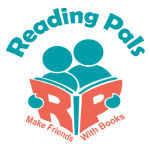Why run a paired reading scheme?
(The following extract is taken from the National Literacy Trust ‘Paired Reading Schemes: a Teacher Toolkit.’)
‘A paired reading scheme involves one pupil (the tutor) supporting another pupil (the
tutee) with their reading. Traditionally, the most effective schemes are where the tutor is
older than the tutee (two years’ difference being the optimal gap) – this is often referred to as cross-age tutoring. Paired reading works successfully in primary and secondary
schools, but also between the two types of schools.
Schools have been running such schemes for many years and the benefits are widely
acknowledged. In September 2011, the University of Durham published the results of the
largest ever trial of peer tutoring in reading with primary school aged children. The impact of the scheme was convincing: Tutees took part in two ten week programmes over the course of two years. Below we have summarised the potential benefits of a well-run paired reading scheme for the tutees, tutors and for the school itself:
Benefits for the tutee
• Improved reading attainment – decoding and comprehension of words and text
• Increased confidence and enjoyment of reading
• Improved attitudes to reading for pleasure and increased amount of reading
outside of school
• Interaction with a positive peer role model – learning from their positive behaviour
• Personal 1-to-1 attention, allowing them to work at their own pace
• Increased sense of belonging in the school community
Benefits for the tutor
• Development of interpersonal skills through experiencing a deeper sense of
responsibility, dedication and pride in being able to help a peer
• Improved speaking and listening skills through asking meaningful questions and
active listening
• Improved attitudes to reading for pleasure and increased amount of reading
outside of school
• Increased sense of belonging in the school community
Benefits for the school
• Improvement in attainment of under-performing pupils in English/reading
• Cost effective
• An effective supplement to high-quality teaching
• Improved school community cohesion – pupils in different year groups getting to
know and supporting each other.’


This positive assessment of cross-age literacy interventions is backed up by research conducted by the Education Endowment Foundation – Peer Tutoring.As Reading Pals has been set up as a Community Interest Company, with an emphasis on benefiting children from socially disadvantaged communities, it is particularly significant that their research indicated: ‘Though all types of pupils appear to benefit from peer tutoring, there is some evidence that children from disadvantaged backgrounds and low attaining pupils make the biggest gains.’
Feedback from children involved in cross-age Reading Pals sessions confirms all of the above-mentioned advantages of peer tutoring. What possibly does not come across in these reports though is how much the children enjoy interacting with their peers in this way. Children repeatedly describe the sessions as fun, and enthusiastically engage in the sessions, frequently asking for them to be continued the following term.

